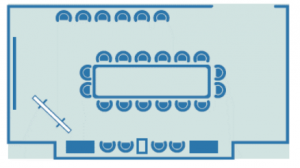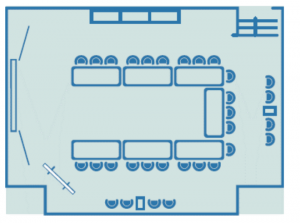Home > BLOG CENTER > Selecting the right conferencing system for a particular room environment
Home > BLOG CENTER > Selecting the right conferencing system for a particular room environment
The maturing of conferencing systems over the last several years means that new technologies and new designs are embodied in a range of systems. This allows for models that are optimized to meet the price and performance goals of different room environments and different user interface requirements. The challenge is to make sure that the selected model will meet the needs of the specific room environment where it will be installed.
Selecting a conference phone with enough microphone pickup to cover the entire room is critical in ensuring that everyone can be heard, especially during dynamic and fast-moving conversations. However, as we look at some specific environments, keep in mind that one important rule to maximize the performance of a voice conferencing system is this: the closer the microphone is to the mouth, the better. No matter what the pickup range of a single microphone may be, as the microphone gets farther from the talker, it’s more likely to pick up noise and room echo. To keep fatigue down and understanding up, if you have someone who you expect to be the most frequent contributor to a conversation, seat them within a few feet of a microphone. If you can’t get them near the console, you can use extension microphones.
Each conferencing environment has its own acoustical challenges that require an appropriately designed conferencing solution. Let’s examine some of these differences.
The small office, home office or very small conference room— This is a relatively small room or office that seats up to four participants. It may have clutter, too many chairs for its modest size, and a low or normal height ceiling. However, this kind of room can deliver some of the best voice conferencing experiences. The chairs and other items cut down possible echo. The small size also forces the talkers to remain close to the microphones, and it places them closer to the loudspeaker. A conference phone with five to seven feet of microphone coverage, one that incorporates the new generation technologies described earlier, will satisfy user expectations in most of these environments.

The standard conference room—This is a more conventional conference room or large office that seats up to 12 participants. The larger size of this room means that there will be additional acoustic challenges (air vents, more participants, more room echo, and noise) that were not present in the smaller room described above. To their credit, however, these rooms typically have carpeting, an acoustical eight-foot ceiling, furniture, drapes, and some wall hangings that all work together to keep the echo under control.

The smaller rooms in this range should be equipped with a conference phone that has 10-12 feet of microphone coverage. Medium and larger conference rooms will require a unit that includes the ability to attach expansion microphones (EX) to fully cover the area.
At a room size of 20 x 30 feet or larger, we reach an inflection point. While this range is within the abilities of the Meeteasy Mini2 EX ,which with expansion microphones, a more powerful conference phone such as the Meeteasy Mid2 EX will deliver a better experience in this environment. Some businesses try using newer but less capable conference phones in these rooms, but this approach provides far less satisfactory results because their algorithms lack the independent pickup and control for larger rooms. The sound will be noisier, less clear, and participants will find it harder to stay focused.
In these larger but acoustically friendly rooms, it is also important to understand the behavior of the participants. If talkers will generally be located near the microphones, the more powerful Meeteasy Mid2 EX conference phones, with expansion microphones and 20-foot microphone reach, is a good choice. This will provide primary quality sound across a 30-foot span and reasonable coverage for the occasional talkers within a 50-foot diameter. But if the primary talkers are spread throughout the room or tend to move around, it is time to consider an installed audio conferencing system.
The boardroom—A large or very large conference room, often running 25 x 45 feet or larger in one or both dimensions, is often designed more for looks than for good sound quality. Its acoustics can suffer due to factors such as large open spaces, hard surfaces, and multiple panes of decorative glass. These rooms often include chairs along a side wall and a worktable or two in the corners. Great sound quality is needed throughout the room and not simply around the main conference table.

This type of room is too big and too distributed for a tabletop system. An installed audio system is needed, because it can accommodate as many microphones as are required to give each talker the clarity and performance they and the listeners require. Such a system can be precisely tuned to overcome the unique challenges of the room acoustics, and will also look “cleaner” because of its ability to work with a much wider variety of microphones and longer (and better concealed) cables. These types of rooms typically hold high-level meetings with “C-level” executives, making an installed system worth the investment, because it will deliver the best sound quality possible.
The offsite—This is a large room with multiple six-foot rectangular tables arranged in an “L” or “U” shape. This type of environment is commonly found in hotels and conference centers. The room is big, but does not have much echo due to its padded sliding room partitions, acoustic ceiling, and carpeted floor. The noise levels are also relatively low.

With these longer “L” or “U” shaped designs, the challenge is to achieve good sound pickup for everyone at the table, while also providing enough volume for everyone to hear the conversation. Meeteasy’s most advanced conference phones, Meeteasy the Mid2 EX provides the capabilities, options and accessories to deliver a great conferencing experience in this environment.
In addition to their audio processing, noise reduction, gain management, and echo cancellation, they include a powerful internal loudspeaker and an output speaker port (optional on the Meeteasy Mid2 EX) capable of driving a full room-size distributed loudspeaker system, including the speaker systems found in many of these rooms. They can use all of these features while maintaining an excellent full-duplex connection over a standard phone or IP network line.
40088 41166info@meeteasy.com.hk
3/F,Building#10, Jiu Xiang Ling Industrial Zone,Xili
Nanshan District, Shenzhen, 518055, China